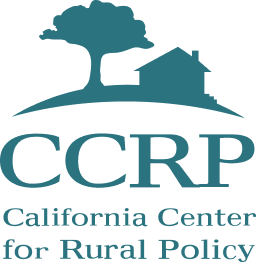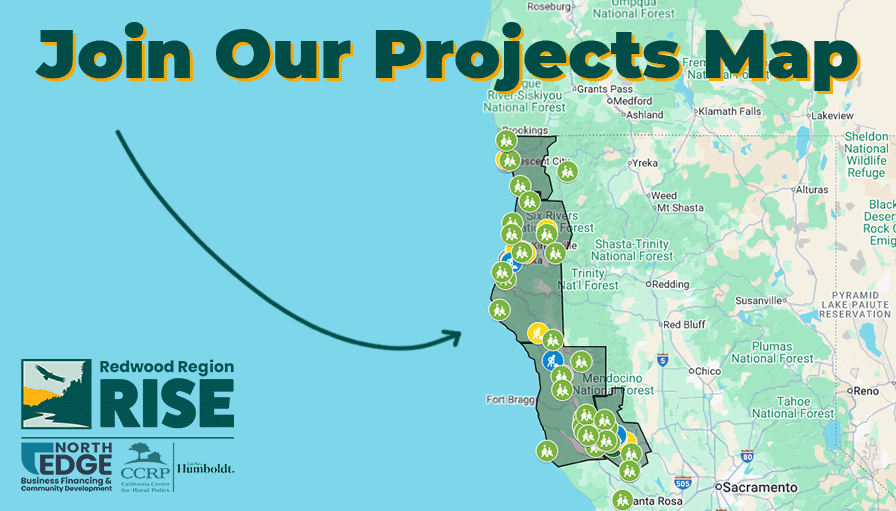Frequently Asked Questions about California Jobs First
1. What is Redwood Region RISE?
Redwood Region RISE (Resilient Inclusive Sustainable Economy) is the name of our Collaborative (one of the 13 regions in California) and comprises Tribal Lands, Del Norte, Humboldt, Lake, and Mendocino Counties. Between January 2023 and the end of August 2024, our Collaborative's Planning Phase focused on crafting economic development strategies--our Regional Roadmap--that boost quality jobs in our regional industries, as well as identifying priorities and investments that align with and advance these strategies.
With the conclusion of the Planning Phase, we have entered the Implementation Phase. This phase is guided by the strategic Regional Roadmap delivered by our Collaborative, which outlines key strategies and proposed investments. These investments, which will be operationalized through Activation Plans, aim to secure funding to bring our plans to fruition.
2. Who are the Conveners of Redwood Region RISE's efforts?
In each region, there is a Convener and a Fiscal Agent; sometimes both functions can be fulfilled by the same organization. For the Redwood Region, the California Center for Rural Policy serves as Regional Convener, and North Edge Financing serves as the Fiscal Agent. Read more about our the Convening Team
3. What is the Collaborative, and how was it formed?
Our Collaborative, like the 13 other Collaboratives throughout the state, engages in California Jobs First's economic development initiative to achieve goals in three areas: equity, climate resilience, and job quality. At present, Redwood Region RISE’s Collaborative is a regional community coalition of 150+ member organizations engaging a community of over a thousand residents working together to implement our Regional Roadmap. To create an inclusive participatory governance mechanism for the group moving forward, a Formation Task Force was assembled. The Task Force included members representing diverse partner groups from across the region. With facilitation support from the Convener, the Task Force created a sustainable and inclusive governance structure, crafted policies and procedures to organize the group moving forward, and created Planning Tables for special topics that need to be covered during the planning process.
4. I am not a part of any formal organization. Can I still contribute to the process?
Absolutely! We encourage community members from across the region and invite you to participate in the process. You can find our Calendar with all meetings and events here. Public Collaborative meetings are held on a quarterly basis, and there are mony other opportunities to participate in our Collaborative, for instance: our Tribal Table, and our Sector Advisory Councils. We'd love to have you on board!
5. How can I get involved? Are there different levels of commitment?
There's lots of way to get involved. A great first step to get involved is to join our mailing list and our Partner Directory. The Redwood Region RISE Collaborative meets quarterly- you can find more information on our meetings here.
If at any time you no longer wish to be engaged in the process, email us at ccrp@humboldt.edu to let us know you would like your name removed from our mailing list.
6. What steps are being taken to ensure that representation from various partners, including Tribal partners, are occurring, and how do we get them involved?
One of the program goals of California Jobs First is to convene representatives from various community groups to the planning table, bringing their perspectives, expertise, and input. North Coast Opportunities (NCO) and True North Organizing Network were our outreach & engagement partners in this process during the Planning Phase. They worked with the California Center for Rural Policy (CCRP) to build a robust mailing list inclusive of the region, representing a diverse range of interests and backgrounds. Members of both these organizations worked with many of our Tribal partners previously and have invited them to join our work. If you know someone or an organization who is not yet involved and is interested in joining the process, please contact us at ccrp@humboldt.edu.
7. Are stipends available for participation?
Yes, stipends (or "per diems") are available for certain meetings for seated members of our Collaborative. Please send us an email at ccrp@humboldt.edu if you have any specific questions.
8. Can the process for submitting projects be kept open on a continuing basis so communities can use it to identify needs?
Absolutely! We've built a Projects Map - a platform to showcase local and regional economic development initiatives aligned with Redwood Region RISE's goals. You can fill out this brief form to get your project featured on the Projects Map. Being featured on the map will help you:
- Gain visibility among local, regional, and statewide interest holders and potential investors
- Connect with aligned initiatives and potential partners from across the Redwood Region
- Receive support from our Sector Investment Coordinators and Collaborative at large
This initiative is about much more than allocating California Jobs First resources. Our hope is that by investing in this regional Collaborative, we can become more competitive for future funding opportunities, more strategic in our efforts, and more centered on inclusivity and sustainability in our investments- far beyond California Jobs First.
9. When are applications for Implementation Funding due?
The State has launched their Implementation Funds RFP, seeking to invest $125 million in key industries, including Aerospace & Defense, Clean Economy, and High-Tech. The State—not Redwood Region RISE—will run their Implementation Phase RFP and award funding on a rolling, competitive basis to projects aligned with the Blueprint’s "Accelerate" and "Bet" categories. Application deadlines are May 28, 2025, and May 22, 2026. While applications are to be submitted through the State, each project must receive a confirmation letter from the regional Convening Team.
10. How does California Jobs First impact existing economic development plans and projects?
One of the goals of California Jobs First is that it “seeks to build on, not overtake existing economic development efforts”. It provides an opportunity to identify shared goals and pursue them from a regional perspective. As Convener, the California Center for Rural Policy has compiled a database of existing strategic plans and initiatives from the Region which should help inform the plan.
11. How are we going to build trust across communities and agencies in all four counties?
Trust takes time to build, it is not a given. The convening team strives to provide full transparency on actions and decisions, solicit input from all working groups in every region, and ensure accessibility to all pertinent documents and meetings.
While there is a parallel Tribal Investment Initiative by the State, Redwood Region RISE is committed to ensuring that Tribal communities can maximize their benefit from both regional and Tribal funding opportunities, and is committed to building the partnerships required to achieve that goal.
We welcome all insight and feedback throughout this process to build and maintain trust with everyone involved.
Join Our Mailing List
Would you like to stay up to date on Redwood Region RISE's efforts? Join our mailing list and receive our monthly RRRISE newsletters, aimed to inform, inspire, engage, and communities across Tribal Lands, Del Norte, Humboldt, Lake, and Mendocino Counties.
If you have subscribed but are having trouble receiving our Mailers, please reach out to Leoni.Fohr@humboldt.edu.


